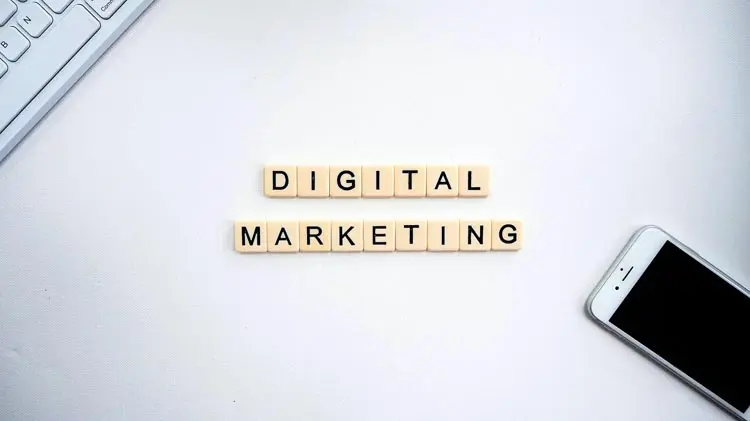1. INTRODUCTION TO “KEY CONCEPTS IN DIGITAL MARKETING”
The field of digital marketing, both intricate and captivating, is a pivotal discipline in today’s business environment. Its broad spectrum covers various interconnected aspects, from strategic planning and data analytics to content creation and stakeholder management. Developing proficiency in digital marketing calls for a comprehensive understanding of these key concepts, enhancing specific skill sets, and embracing a culture of continuous learning.
Becoming a digital marketer necessitates gaining expertise across multiple domains, each with its distinct yet interconnected elements. These domains encompass planning, management, strategy, analytics, platforms, techniques, media, tools, and professional development. By delving into these realms, one not only becomes familiar with the marketing landscape but also gains the ability to traverse it skillfully, achieving desired outcomes in an increasingly digital world.
Planning in digital marketing involves identifying your goals, target audience, and the best channels to reach them. It requires understanding customer behaviour and trends, creating a content calendar, and setting Key Performance Indicators (KPIs) to measure success.
Management in this context involves overseeing and coordinating various marketing efforts, managing teams, and ensuring tasks are executed within the established timeframe and budget. It’s about providing leadership, fostering collaboration, and driving the team towards shared goals.
Strategy entails developing an approach to achieve your marketing objectives. This involves understanding the company’s mission, the market landscape, competition, and how to create a unique value proposition. The strategic framework guides the direction and scope of marketing efforts.
Analytics provide actionable insights about the performance of your marketing initiatives. With tools such as Google Analytics, marketers can measure the effectiveness of campaigns, user engagement, conversion rates, and more. This data-driven approach allows for adjustments and improvements to the strategy based on real-time feedback.
Platforms are the digital channels used to reach and engage your target audience. They include social media networks, email marketing platforms, Search Engine Optimization (SEO) and Pay-Per-Click (PPC) platforms, among others. Understanding these platforms, their strengths, weaknesses, and best use cases, is key to successful digital marketing.
Techniques refer to the specific methods used to implement your marketing strategy. These may include SEO, content marketing, social media marketing, email marketing, influencer marketing, among others. Each technique requires a different skill set and understanding to use effectively.
Media in digital marketing refers to the channels or platforms that transmit information to the target audience. This could range from owned media (websites, blogs), earned media (reviews, shares), or paid media (ads, sponsored content).
Tools are the software or services that aid in the execution, management, and analysis of digital marketing campaigns. These include content management systems, social media management tools, email marketing software, analytics tools, etc.
Finally, Professional development refers to the continuous learning and improvement process. Digital marketing is a dynamic field, and staying updated with new trends, techniques, and technologies is crucial for ongoing success.
This report offers a comprehensive guide to these key concepts in digital marketing, providing an in-depth understanding of each. As you progress through the sections, you will not only become familiar with the theoretical foundations of digital marketing but also gain practical insights into its application, helping you develop the expertise, strategies, and job templates needed for a successful career in digital marketing. The goal is for every reader to glean a profound understanding of digital marketing after perusing this report, enabling them to effectively strategize and implement robust digital marketing campaigns.
2. TABLE OF CONTENTS
- Introduction
- Table Of Contents
- Digital Marketing
- Outbound Marketing
- Inbound Marketing
- Content Marketing
- Digital Brand
- Targeting
- Skills
- Platforms
- Responsibilities
- Keeping Up To Date
- Analytics Tools
- Content Creation
- Storytelling
- Processes
- Roles
- Disciplines
- Career
- Conclusion
3. DIGITAL MARKETING

At the heart of the modern business ecosystem lies Digital Marketing – a discipline that integrates technology, data, content, and communication to engage customers, build relationships, and ultimately drive growth. This domain thrives on customer interactions in the online environment, capitalizing on the organized and often permanent nature of online information to establish and maintain relationships. The power of Digital Marketing lies not only in its reach and accessibility but also in its capacity for detailed analysis and direct feedback, enabling data-driven decision-making and robust development of products, services, and brands.
Digital Marketing represents a paradigm shift from traditional marketing. Unlike its predecessor, which is often unidirectional and difficult to measure, digital marketing allows for bi-directional communication and precise measurement of engagement. This shift introduces a multitude of opportunities and challenges that marketers must navigate to achieve success.
One of the foundational principles of Digital Marketing is the capability to engage with customers on their terms, in their preferred online environments. This customer-centric approach may manifest through various channels, such as social media, emails, mobile apps, websites, and more. Each platform provides unique opportunities for interaction and engagement, be it through shared content, comments, reviews, or direct messages.
However, the real magic of Digital Marketing lies in its ability to build upon these interactions to create and nurture long-term customer relationships. By strategically leveraging online data, digital marketers can understand their customers’ behaviours, preferences, and needs, and tailor their marketing efforts accordingly. They can track the customer journey, identify touchpoints, and optimize experiences to foster customer loyalty and advocacy. This process, often referred to as Customer Relationship Management (CRM), is a vital aspect of effective digital marketing.
The pivotal role of analytics tools in Digital Marketing cannot be overstated. These tools enable marketers to gather valuable customer data, providing insights into consumer behaviours, campaign performance, and market trends. By analyzing this data, marketers can make informed decisions about their marketing strategies, continuously improving and adapting to achieve their goals. Tools like Google Analytics, SEMrush, and HubSpot offer comprehensive analytics features that help marketers track their Key Performance Indicators (KPIs), monitor campaign results, and optimize their strategies based on real-time feedback.
Moreover, Digital Marketing enables the creation and delivery of personalized content. By understanding customer personas and their digital footprints, marketers can tailor their messages to resonate with each segment of their audience, driving engagement and conversion rates. This ability to personalize at scale is a unique strength of digital marketing, empowered by tools like Customer Data Platforms (CDPs) and AI-driven algorithms.
In summary, Digital Marketing represents a confluence of customer interaction, data-driven decision making, and online relationship building. It empowers businesses to understand and cater to their customers’ needs, transforming the way brands interact with their audience. By leveraging analytics tools and direct feedback, Digital Marketing offers unparalleled opportunities for product, service, and brand development, making it an essential skill set in the modern marketing landscape.
4. OUTBOUND MARKETING

Outbound Marketing, often described as traditional or interruption-based marketing, refers to any marketing strategy where a company initiates the conversation by sending its message out to a broad or specific audience. From direct mail and print advertisements to telemarketing and mass emails, the objective of outbound marketing is to reach out to prospects and convey the brand message, usually pitching a product or a service.
However, it’s essential to understand that outbound marketing isn’t just about blanket broadcasting. It is an art and science of engaging potential customers through crafted narratives, persuasive messaging, and compelling calls-to-action. Moreover, as the marketing landscape evolves, so too does the approach and methodologies of outbound marketing.
In the digital age, traditional outbound tactics have been reimagined. Today’s outbound marketers need to be savvier than simply distributing flyers or making cold calls. They need to leverage technology and data to understand their target audience, craft personalized messages, and reach out at the right time through the right channel.
For instance, consider Email Marketing, a classic outbound strategy. Modern email marketing isn’t about mass, impersonal emails. Instead, it’s about sending targeted, personalized messages based on the recipient’s behaviour, preferences, and stage in the customer journey. Tools like MailChimp or Constant Contact allow marketers to segment their audience, automate their campaigns, and track their performance, making email marketing more effective and efficient.
Telemarketing, too, has evolved. Rather than cold-calling random numbers, companies now use data to identify potential leads and contact them with tailored offerings. Some even use predictive analytics to determine the best time to call and the likelihood of a successful engagement.
Similarly, Direct Mail has found new life in the digital age. Companies are using customer data to create personalized, high-quality printed materials that resonate with the recipient. Rather than a mass-produced flyer, recipients might receive a beautifully crafted catalog tailored to their tastes and preferences.
That said, it’s important to remember that while outbound marketing can be effective, it can also be intrusive, especially if not done thoughtfully. This is why modern outbound marketers need to balance their strategies with permission-based, customer-centric approaches to ensure they don’t alienate their audience. They also need to comply with regulations like the CAN-SPAM Act for emails and the Telephone Consumer Protection Act for calls, which protect consumers from unwanted marketing.
In conclusion, outbound marketing is all about initiating conversations and spreading brand awareness. While traditional in nature, its principles remain critical in the modern marketing mix. Its effectiveness can be greatly enhanced when it is used thoughtfully, with an understanding of the target audience, and in combination with inbound marketing strategies. This approach ensures a balance between reaching out to new prospects and nurturing existing customer relationships.
5. INBOUND MARKETING

Inbound Marketing, a term coined by HubSpot co-founder Brian Halligan, is an approach designed to draw customers to a company’s products or services organically, typically through the creation of valuable content and experiences tailored to them. As opposed to the traditional “outbound” marketing methods, which involve businesses reaching out to potential customers, inbound marketing earns the attention of the customers, making it easier for them to find the business when they need its products or services.
In today’s digital age, with consumers having the power to block out disruptive outbound marketing messages, inbound marketing has become a critical component of any effective marketing strategy. It’s not just about reaching out to the audience; it’s about providing them with meaningful content that pulls them toward your company and products because they genuinely want to interact with you.
Inbound marketing strategy includes four main pillars: Attract, Convert, Close, and Delight. Let’s delve deeper into these stages.
- Attract: The initial stage is about attracting the right audience who are most likely to convert into leads. This involves creating high-quality, relevant content that answers questions or solves problems for your target audience. Search engine optimization (SEO), blogging, social media marketing, and targeted keyword strategies are common tactics used in this stage.
- Convert: Once you’ve attracted visitors to your site, the next step is converting them into leads by obtaining their contact information, often through a value exchange. Lead magnets, such as eBooks, whitepapers, webinars, free trials, or even newsletters, can be offered in exchange for contact details. Landing pages, forms, and calls-to-action play vital roles in this stage.
- Close: At this point, the leads are nurtured through targeted marketing automation, email marketing, and CRM strategies until they’re ready to become customers. Using techniques like lead scoring, which ranks leads based on their engagement and behavior, marketers can determine which leads are sales-ready and thus need a more direct approach.
- Delight: This final stage is about turning customers into promoters. This is achieved by continuing to engage, surprise, and deliver outstanding customer service even after the sale is made. The use of social listening, surveys, and personalized email campaigns help keep customers satisfied and more likely to refer others to your business.
In summary, inbound marketing is a holistic, data-driven approach that leverages content on your website to attract buyers researching their options online. It’s more than just generating leads; it’s about establishing authority and earning trust by providing prospective customers with information they value at every stage of their buying journey. By aligning the content you publish with your customer’s interests, you organically attract inbound traffic that you can then convert, close, and delight over time. This in-depth understanding of inbound marketing is vital for any digital marketer to succeed in today’s customer-centric business landscape.
6. CONTENT MARKETING

6. CONTENT MARKETING
Content marketing is a strategic marketing approach focused on creating, publishing, and distributing valuable, relevant, and consistent content to attract, engage, and retain a clearly defined audience — ultimately, to drive profitable customer action. Rooted in the age-old practice of storytelling, it transcends the conventional modes of hard-sell advertising by offering consumers information they find inherently valuable. This positions your brand not merely as a seller of a product or service, but as an industry authority and resource.
The aim of content marketing isn’t to sell directly, but to build a relationship with your audience. By consistently providing useful content, you establish trust and credibility, which over time can convert audience members into customers. This conversion, however, isn’t where the story ends; content marketing plays a crucial role in creating loyal customers and even brand advocates, through continuous engagement and re-engagement tactics.
To understand the concept of content marketing more deeply, let’s dissect its core components:
- Creation of High-Quality Content: Content isn’t limited to blog posts or articles. It spans a wide array of formats, including videos, podcasts, social media posts, webinars, eBooks, infographics, case studies, newsletters, and more. High-quality content is original, engaging, and provides value to the reader. It effectively communicates your brand’s story, values, and offerings in a non-intrusive manner.
- Search Engine Optimization (SEO): Quality content is the backbone of SEO. By researching and using relevant keywords, optimizing images, and creating quality backlinks, you can improve your website’s visibility on search engine results pages (SERPs), leading to increased site traffic.
- Social Media Strategy: Social media is a vital platform for sharing and promoting your content, allowing you to engage with your audience directly. It serves as an avenue for content distribution and can also be used to gather audience insights.
- Conversion Rate Optimization (CRO): This involves analyzing the behavior of visitors and using this data to improve your website and content strategy. The goal is to increase the percentage of website visitors who complete a desired action on a webpage, like filling out a form or making a purchase.
- Performance Tracking and Analytics: Understanding which content pieces are performing well (and why) is key to refining your strategy. This is done using analytics tools that track metrics like page views, time spent on page, bounce rate, conversion rate, social shares, and more.
- Continuous Improvement: Content marketing is not a set-and-forget strategy. It requires continuous testing, learning, and optimizing based on data, trends, and customer feedback.
In summary, content marketing is a long-term strategy that uses content (in a variety of formats) to build a stronger relationship with your audience, capture their attention, improve engagement, and improve brand recall. As a digital marketer, understanding the ins and outs of content marketing is integral to creating a robust digital marketing strategy. Remember, content is not only king but the kingdom itself.
7. DIGITAL BRAND

Digital branding is a sub-domain of branding which deals primarily with the digital landscape. More than just a logo or a tagline, it encompasses all aspects of an entity’s online persona, including its mission, values, visual identity, tone of voice, and customer experience across all digital touchpoints. A digital brand has to be strong, consistent, and authentic to stand out in the saturated digital landscape and build lasting relationships with customers.
A digital brand has several key components:
- Brand Identity: This includes the name, logo, tagline, typography, color schemes, imagery, and any other visual elements that represent the brand. These should be consistent across all digital platforms and communication materials to create a coherent and recognizable identity.
- Brand Message: The core messages of your brand should effectively communicate your mission, vision, values, and unique selling propositions (USPs). This message should resonate with your target audience, addressing their needs, aspirations, or challenges.
- Brand Personality: This refers to the human characteristics attributed to your brand. Is it professional and sophisticated, or friendly and casual? Defining a clear brand personality shapes the tone of voice used in all communications and interactions, allowing consumers to connect on an emotional level.
- Brand Experience: This pertains to how customers perceive their interactions with the brand across all digital channels. It includes the user experience on your website, the level of engagement on social media, customer service encounters, and the overall impression left on the consumer.
- Consistency: Consistency is key in digital branding. The brand should remain consistent across all channels, platforms, and communications. This consistency strengthens brand recognition and builds trust among customers.
- Authenticity: Authenticity is crucial for establishing trust and loyalty among consumers. The brand should communicate honestly and transparently, showing genuine care for its customers and society at large.
- Adaptability: In the digital age, things change rapidly. Therefore, it’s essential for a digital brand to be adaptable and flexible, ready to evolve with changes in technology, market trends, or consumer behavior, while still maintaining its core identity and values.
- Analytics and SEO: A digital brand needs to be visible and easy to find online. This involves understanding and optimizing for search engine algorithms and using analytics to measure, track, and improve performance.
By meticulously crafting and managing these elements, a digital marketer can establish a robust digital brand that engages, connects with, and instills loyalty in its target audience. Such a brand won’t just be seen as a provider of products or services, but as a valued part of consumers’ lives.
8. TARGETING

The ability to target specific segments of consumers is one of the great advantages of digital marketing. Through various tools and strategies, businesses can reach out to individuals who are most likely to be interested in their products or services, based on their demographics, interests, behaviour, and more. However, with this capability comes an essential responsibility: to respect and protect consumers’ privacy rights. Adherence to privacy laws and regulations is not just an ethical obligation; it’s a legal one that could carry significant consequences if violated.
A. Understanding Consumer Targeting
Consumer targeting in digital marketing entails identifying and reaching specific subsets of a general population based on certain characteristics. These characteristics could be demographic (e.g., age, gender, location, income), psychographic (interests, attitudes, values), behavioural (browsing habits, purchase history), or related to their stage in the buying cycle.
B. The Importance of Consent
One critical aspect of targeting in digital marketing is obtaining consent. This is especially relevant when collecting and using personal data. Users should have a clear understanding of what data is being collected, how it will be used, and with whom it might be shared. Consent should be clearly obtained, not presumed or forced, and users should have the option to withdraw it at any time.
C. Privacy Laws and Regulations
Privacy laws and regulations, such as the General Data Protection Regulation (GDPR) in the EU and the California Consumer Privacy Act (CCPA) in the U.S., place strict requirements on how businesses collect, store, use, and share personal data. Compliance with these laws is crucial, not only to avoid substantial fines and legal actions but also to maintain trust and reputation among customers.
D. Privacy-Centric Targeting Strategies
Adhering to privacy regulations doesn’t mean that businesses can’t target consumers effectively. It means they need to do so in a privacy-centric way. This could include targeting based on anonymized data, aggregate behaviour, or contextual factors, rather than personal data. Or it could involve strategies such as privacy sandboxes, which aim to balance targeted advertising with user privacy.
E. Building Trust
Adhering to privacy laws and regulations, respecting users’ rights, and being transparent about data practices are all crucial for building trust with customers. Businesses that demonstrate they value their customers’ privacy are more likely to build lasting relationships and secure customer loyalty.
By understanding and applying these aspects, a digital marketer can effectively target potential customers while staying within the bounds of privacy laws and regulations, thus protecting the business from legal repercussions and, at the same time, fostering a relationship of trust with their customers.
9. SKILLS

In an increasingly connected world, where over half the population has internet access, digital marketers hold the key to vast opportunities. Yet, while successful digital marketing campaigns can reap rich rewards, a few missteps can also lead to spectacular failures. Hence, for any aspiring digital marketer, mastering a certain set of skills is crucial. Here are the key skills that a digital marketer should possess:
A. Bridging Skills
Often, digital marketers have to deal with challenging situations or difficult questions. The ability to “bridge” the conversation from a negative or sensitive topic to a more positive or neutral one is a vital skill. This involves acknowledging the initial issue or question but then subtly steering the conversation to another related but more favorable area. Originality and creativity in storytelling can help achieve this. It’s all about managing and shaping public perception effectively.
B. Presentation Skills
Effective communication is a bedrock of digital marketing. The ability to deliver engaging, lively, insightful, and confidence-inspiring presentations, whether during a podcast or in front of coworkers, can significantly impact one’s digital marketing career. Individuals with strong public speaking and presenting skills often find themselves in leadership roles, as they can inspire and guide teams effectively.
C. Media Production Skills
In today’s information age, relying solely on text-based marketing campaigns will not yield results. High-quality, engaging, and attention-grabbing visual and audio elements are a must. This calls for skills in:
- Videography (ex: Apple Final Cut Pro) – Creating compelling video content can significantly enhance audience engagement.
- Photography (ex: Mirrorless or DSLR Cameras) – High-quality images can augment the visual appeal of any marketing content.
- Presentation (ex: Apple Keynote) – Being able to deliver engaging presentations is a crucial aspect of marketing.
- Graphic Design (ex: Adobe Photoshop) – This helps in creating eye-catching visuals and infographics.
- Audio Editing (ex: Audacity) – Clear and well-edited audio enhances the user experience of podcasts and video content.
D. Project Management Skills
Digital marketing often requires skills similar to those of a successful project manager. The ability to lead, communicate effectively, schedule tasks, manage risks and costs, negotiate, think critically, manage tasks, and ensure quality are all vital. These skills help push forward projects to completion, overcoming challenges along the way.
E. Analytics Skills
Finally, one of the most important skills a digital marketer can possess is the ability to understand and utilize analytics. This skill allows them to determine what’s working and what’s not, enabling them to tweak their marketing campaigns as necessary. It also allows them to analyze public engagement, understand audience perception, and approach problems from an evidence-based perspective. Using analytics, digital marketers can generate insightful reports and make data-driven decisions.
In conclusion, a blend of these skills can equip a digital marketer to create, manage, and optimize potentially successful online marketing campaigns. The ability to leverage these skills effectively can be a significant differentiator in the digital marketing landscape.
10. PLATFORMS

The digital marketing landscape offers a plethora of platforms that professionals can utilize to maximize their outreach, improve customer relationships, analyze performance, and manage content seamlessly. Each of these platforms serve unique purposes, contributing to a comprehensive and effective digital marketing strategy. Here, we delve deeper into the key types of platforms used by digital marketing professionals:
A. Advertising Platforms – These platforms (e.g., Facebook Ads, Google Ads) provide businesses with the opportunity to advertise their products or services to a targeted audience based on demographics, interests, browsing behavior, and more. They also offer advanced analytics to measure the success of advertising campaigns and optimize them for better performance.
B. Customer Relationship Management (CRM) Platforms – CRM platforms (e.g., Salesforce, HubSpot CRM) are essential tools for businesses to manage interactions with their existing and potential customers. These platforms help to streamline processes, nurture leads, improve customer service, manage customer data, and enhance relationships, leading to increased customer retention and sales growth.
C. Content Management Systems (CMS) Platforms – CMS platforms (e.g., WordPress, Drupal) empower users to create, manage, and modify website content without the need for specialized technical knowledge. These systems provide a user-friendly interface and tools to manage every aspect of a website’s content, from text and images to multimedia and other interactive elements.
D. Social Media (SM) Platforms – Social media platforms (e.g., Facebook, Instagram, Twitter) allow users to connect and engage with each other, share content, and form online communities. Businesses can leverage these platforms to increase brand awareness, engage with customers, gather feedback, provide customer support, and promote products or services.
E. Social Media Management (SMM) Platforms – Managing multiple social media accounts across various platforms can be a daunting task. SMM platforms (e.g., Hootsuite, Buffer) simplify this process by providing a centralized interface to manage all social accounts, schedule posts, engage with the audience, and measure the effectiveness of social media campaigns.
F. Analytics Platforms – Analytics platforms (e.g., Google Analytics, Adobe Analytics) provide valuable insights into website performance, audience behavior, marketing campaign effectiveness, and more. They allow businesses to track, analyze, and report on a range of data, informing strategic decisions and helping to optimize marketing efforts for better ROI.
G. Email Marketing Platforms – Email marketing platforms (e.g., MailChimp, Constant Contact) enable businesses to design, send, and track email campaigns. They offer tools for segmenting the customer base, personalizing emails, automating email sequences, and analyzing campaign performance.
Understanding and effectively utilizing these platforms is crucial for digital marketing professionals. They provide the tools and insights needed to develop and execute successful marketing strategies, engage with customers, analyze performance, and adapt to changing trends and customer needs.
11. RESPONSIBILITIES

In the dynamic world of digital marketing, professionals are tasked with a wide array of responsibilities that play a critical role in shaping a brand’s online presence and driving its growth. Here, we expand on each responsibility, linking it to core marketing principles and practices:
A. Online Brand Development – This responsibility requires marketers to proactively participate in online communities, forums, and social media networks to build brand recognition and credibility. It’s not simply about promoting products or services, but about fostering relationships and generating valuable conversations. Online brand development can also involve managing a brand’s online reputation, addressing customer concerns, and demonstrating thought leadership. The success of this endeavour often hinges on the marketer’s understanding of their target audience and the value they can provide through meaningful engagement.
B. Content Marketing – Content marketers are charged with creating and curating valuable, relevant, and consistent content aimed at attracting and retaining a clearly defined audience. This could involve writing blog posts, creating videos, designing infographics, developing webinars, and more. It also includes strategic elements like understanding customer journey, performing SEO keyword research, and managing a content calendar. Effective content marketing drives profitable customer action by building trust and authority amongst your audience.
C. Influencer Marketing – This involves partnering with influential individuals who have built a strong online following, and whose audience aligns with the marketer’s target demographic. Influencer marketing can provide brands with unique access to engaged, niche audiences, boosting brand awareness and credibility. Success in this realm often involves identifying the right influencers, developing mutually beneficial partnerships, and crafting authentic campaigns that resonate with the influencer’s audience.
D. Domain Authority – Domain Authority (DA) is a search engine ranking score that indicates a website’s likelihood to rank on search engine result pages (SERPs). It’s a key factor in Search Engine Optimization (SEO) that influences how a website ranks on search engines like Google. Building high DA involves generating high-quality, relevant backlinks, creating engaging, SEO-friendly content, improving technical SEO, and providing a positive user experience on the website. The process can be complex and requires consistent, long-term effort, but the benefits include increased organic traffic, higher search engine rankings, and greater online visibility.
These responsibilities illustrate the diverse skill set digital marketing professionals must develop. Each task requires a unique combination of strategic thinking, creativity, technical know-how, and an in-depth understanding of both the brand they represent and the audience they aim to reach. By effectively executing these responsibilities, digital marketers can create a strong online presence, drive customer engagement, and ultimately, propel business growth.
12. KEEPING UP TO DATE

In a rapidly evolving field like digital marketing, professionals need to stay current with industry trends, emerging technologies, and best practices. This responsibility calls for ongoing learning and professional development. Here we discuss two popular methods for staying up-to-date, and how each can be maximized to benefit different career stages and objectives.
A. Online Professional Development Courses – Massive Open Online Course (MOOC) providers such as EdX, Coursera, Udacity, LinkedIn, and Udemy offer a wide range of courses in digital marketing. These courses cover everything from foundational concepts to the latest trends, like data-driven marketing, AI in marketing, and user experience (UX) design. Many courses are developed and delivered by leading industry professionals and acclaimed academics, ensuring that content is both cutting-edge and grounded in proven strategies. Learning can be self-paced, and certification upon completion provides a tangible benchmark of achievement.
However, it’s important to note that the quality of courses can vary, so always look for courses that are highly-rated and recommended by other professionals. Make sure the course is relevant to your current needs or career goals – whether you’re just starting out, looking to master a particular technique, or aiming to understand strategic aspects of marketing.
B. Professional Digital Marketing Conferences – Attending professional conferences provides a wealth of benefits. They are ideal platforms for networking, gaining insights from industry leaders, and staying abreast of the latest trends and strategies. Importantly, conferences often offer a more hands-on and interactive learning experience than online courses, with workshops, panel discussions, and Q&A sessions.
But not all conferences are created equal. Some are more strategic, targeting marketing leaders, CEOs, and other decision-makers, focusing on broad trends, industry outlooks, and leadership challenges. Others are more tactical, geared towards practitioners who are looking for practical skills and knowledge they can apply immediately in their jobs. Be clear about what you want to get out of a conference before deciding to attend. Research the speakers, agenda, and past events to ensure it aligns with your professional development needs.
Keeping up to date in digital marketing is a multifaceted process that combines active learning with networking and industry engagement. It requires a commitment to continuous improvement and a keen interest in the evolution of the marketing landscape. Both online courses and professional conferences offer unique advantages, and the best approach often involves leveraging a mix of these resources to create a rounded and dynamic skill set.
13. ANALYTICS TOOLS

Data-driven decision-making is at the heart of modern digital marketing, and analytics tools are indispensable in providing the insights needed to make these decisions. These tools help marketers understand user behavior, track campaign performance, spot emerging trends, and gain a competitive edge. Two critical tools in the digital marketer’s toolkit are:
A. Google Analytics – This is one of the most widely used web analytics tools in the world, and for good reason. Google Analytics allows marketers to monitor and analyze a broad range of data related to website traffic, including the number of visitors, their demographic information, the duration of their visits, the pages they visited, and the source of the traffic (i.e., direct, referral, organic search, paid search, social).
Furthermore, Google Analytics allows for goal setting and conversion tracking, enabling marketers to understand how visitors interact with their websites and at what rate they’re completing desired actions (such as signing up for a newsletter, downloading a report, or making a purchase). Marketers can also gain insights into user behavior through features such as behavior flow reports, which map the path users take through a website.
By leveraging these data, digital marketers can optimize their websites, adjust their strategies, and improve their ROI. They can identify high-performing content, spot bottlenecks in user journeys, and pinpoint opportunities for growth.
B. Google Trends – This tool is a treasure trove of information for marketers seeking to understand market dynamics and consumer interests. Google Trends provides data on the popularity of search terms over time and across regions, allowing marketers to identify trending topics, seasonality in search behavior, and geographic differences in interests.
Google Trends can inform various aspects of a digital marketing strategy. For instance, by identifying trending keywords, marketers can create timely and relevant content that drives traffic. By understanding seasonality, they can better time their campaigns. And by pinpointing regional interests, they can tailor their strategies to specific markets.
These two tools, when used in conjunction, can provide digital marketers with a comprehensive understanding of both their website performance and the broader market context. However, these are only the tip of the iceberg when it comes to analytics tools. There are numerous other tools available, each with its own strengths and specialties, such as SEMrush for SEO and competitive analysis, HubSpot for inbound marketing analytics, and Hootsuite for social media analytics. Choosing the right mix of tools requires a clear understanding of your specific needs and goals.
14. CONTENT CREATION

The digital landscape thrives on engaging content; it’s what attracts and retains customers, boosts visibility, and enhances brand reputation. The art of content creation requires a mix of creativity, strategy, and technical skills. Knowing how to leverage digital content creation tools effectively can significantly streamline the process and enhance the quality of the output. Here are some core digital content production tools that digital marketers should be proficient in:
A. Final Cut Pro – This is a professional video editing software developed by Apple Inc. It’s used for editing, processing, and producing high-quality videos. With the rise of video content on social media platforms and its impact on audience engagement, having proficiency in Final Cut Pro can be a great asset. The software allows users to edit footage, adjust color balance, add special effects, manipulate sound, and much more, enabling them to create captivating videos that resonate with their audience.
B. Adobe Photoshop Elements – A lighter, more user-friendly version of Adobe Photoshop, this software is ideal for basic photo editing and graphic design tasks. With Adobe Photoshop Elements, marketers can adjust the color and lighting of images, remove imperfections, create collages, add text and effects, and more. These capabilities can be invaluable in creating visually striking social media posts, website images, and email graphics.
C. Keynote – Developed by Apple Inc., Keynote is a presentation software that is especially known for its intuitive interface and impressive design capabilities. Marketers can use Keynote to create stunning presentations for business meetings, webinars, online courses, and more. Its variety of templates, animation options, and multimedia integration features can help make presentations more engaging and impactful.
D. Audacity – This free, open-source software is a versatile tool for recording and editing audio. With the popularity of podcasts and the use of audio in video production, Audacity can be a handy tool for digital marketers. It allows users to record live audio, cut, copy, splice or mix sounds, and add effects, among other features.
E. Pixabay – In today’s visual-centric digital sphere, having access to high-quality images is essential. Pixabay hosts an extensive collection of royalty-free images, videos, and music that can be used commercially. These resources can be used in everything from social media posts to blog articles, adding a visual element that can engage audiences and increase click-through rates.
Remember, the key to effective content creation isn’t just about knowing how to use these tools. It’s also about understanding your audience, being able to create content that resonates with them, and continually testing and adapting your content strategy based on performance metrics. These tools, combined with strategic thinking and creativity, can empower digital marketers to create compelling content that drives engagement and conversions.
15. STORYTELLING

Storytelling is an ancient art form that has been used by civilizations throughout history to share knowledge, inspire action, and foster connections. In the digital marketing realm, storytelling transcends the simple conveyance of information. It is a strategic approach that can spark interest, evoke emotions, and influence behaviour, creating a powerful impact that goes beyond traditional marketing tactics.
Digital marketers employ storytelling to bring a brand or product to life in a memorable and engaging way. Here is a deeper understanding of why storytelling is a fundamental skill in digital marketing:
- Communicates Broadly: An effective story transcends demographic boundaries. It speaks to universal human experiences and emotions, making it more likely to resonate with a diverse audience. This universal appeal can significantly expand the reach and impact of a marketing campaign.
- Engages Emotionally: Stories have the power to engage the audience on an emotional level. Emotional engagement can create a deeper connection between the consumer and the brand, foster loyalty, and drive purchasing decisions. It’s this emotional connection that often differentiates successful brands from their competition.
- Promotes Empathy: Good storytelling allows the audience to see themselves in the narrative. This promotes empathy, enabling consumers to understand and appreciate the benefits of a product or service on a personal level.
- Motivates Action: Stories can inspire and motivate action. When consumers identify with a story, they are more likely to take the desired action, whether it’s making a purchase, sharing content, signing up for a newsletter, or advocating for a brand.
- Simplifies Complex Ideas: Storytelling can distill complex ideas into digestible, relatable narratives. By presenting information in a story format, marketers can make complicated products or concepts easier for consumers to understand and appreciate.
While storytelling is a powerful tool, it requires skill to execute effectively. Successful storytelling in digital marketing involves understanding the audience, crafting a compelling narrative, integrating the story across marketing channels, and continually evaluating and refining the narrative based on feedback and results. As such, storytelling is not just a skill; it’s a strategic approach that, when done well, can drive engagement, loyalty, and growth for a brand in the digital space.
16. PROCESSES

In the digital marketing realm, processes are the backbone that hold your operations together, ensuring consistency, efficiency, and productive collaboration. Four key processes stand out as critical for digital marketers, especially when working with larger corporations or managing large-scale projects.
- Vendor Process: When acting as a vendor for a larger corporation, it’s vital to adapt to their existing processes and procedures. These corporations usually have established routines coordinated by their procurement department, and following these procedures is paramount for the smooth running of operations. Compliance is more than just administrative diligence; it demonstrates your agency’s professionalism, reliability, and ability to work within established frameworks. Therefore, understanding and abiding by the client’s vendor process, even if it involves extensive documentation and communication, will build trust and facilitate the workflow.
- Proposal Process: Submitting a work proposal to a corporation requires detailed planning and accurate costing. A well-crafted proposal outlines not only the scope of work and the deliverables but also a comprehensive cost analysis. This estimate should account for all foreseeable expenses and include a contingency buffer for unforeseen cost overruns. A thorough and precise proposal process shows the client your agency’s professionalism, transparency, and risk management capabilities.
- Project Management Process: Project management applications are indispensable tools for digital marketers. They streamline the process of organizing, scheduling, and directing a digital marketing campaign, facilitating collaboration, task tracking, and communication. The value of a project management tool lies in its ability to create universally understood documents and reports that keep all team members aligned and informed. Selecting a tool that best fits your team’s needs and workflow can significantly enhance productivity and project outcomes.
- Stakeholder Communication Process: Communication with stakeholders must be a well-structured and pre-planned process. Throughout the project, teams generate and discuss vast amounts of granular and specific data. This raw data needs to be filtered, organized, and summarized into digestible, relevant information for stakeholders. Establishing a regular communication schedule and format helps keep stakeholders informed without overwhelming them with excessive detail. It is about conveying the right information, at the right level of detail, to the right people, at the right time.
These processes form an integral part of the digital marketing ecosystem. By implementing and adhering to them, digital marketers can enhance efficiency, improve project outcomes, and foster more fruitful relationships with clients and stakeholders. They serve as a roadmap for the digital marketer, guiding their actions and decisions in the complex landscape of digital marketing.
17. ROLES

The dynamic world of digital marketing offers a wide variety of roles, each demanding its own unique set of skills and experiences. The progression in this industry, while not strictly linear, usually follows a path from junior roles to leadership positions. Below we detail the core roles within digital marketing, progressing from the least to most experienced:
- Volunteer Marketer: Entering the marketing profession can be challenging for those without previous experience. Volunteering as a marketer for non-profit organizations or charities provides invaluable hands-on experience and a foundation in practical marketing activities. Here, an individual may learn the basics of digital marketing such as content creation, social media management, and email marketing while contributing to a good cause.
- Digital Marketing Intern: Securing a paid internship is a valuable next step for those with a relevant degree or coursework, such as in marketing, journalism, graphic design, communications, business, e-commerce, creative writing, photography, or information technology. Interns may engage in a variety of tasks to gain a broader understanding of the field, potentially including competitor analysis, content creation, and analytics tracking.
- Digital Marketing Assistant: Moving up from an internship, a digital marketing assistant is often the first full-time role. Assistants support the team with tasks such as responding to client inquiries, posting on social media, and writing marketing content. The role demands agility, creativity, and a willingness to learn.
- Digital Marketing Coordinator: A coordinator manages project communications, follows up on leads, conducts market research, and organizes marketing events. This role requires higher-level strategic thinking, excellent organizational skills, and often, familiarity with project management tools.
- Digital Marketing Manager: Managers oversee all marketing activities within an organization, ensuring alignment with the strategic plan. In smaller companies, managers might also create graphics, write content, and manage website administration. This role demands a comprehensive understanding of marketing strategies, strong leadership skills, and proficiency in various marketing tools.
- Digital Marketing Executive: Digital Marketing Executives manage budgets, schedules, and campaigns, monitor spending, analyze web traffic, research SWOT (Strengths, Weaknesses, Opportunities, Threats), and create reports. This role requires strong analytical skills, financial acumen, strategic thinking, and a high level of responsibility.
- Digital Marketing Head: This role involves developing the marketing vision, leading the marketing team, ensuring brand guideline adherence, attending industry events, recruiting new team members, and reporting to the Director of Digital Marketing. It demands excellent leadership, strategic vision, strong communication skills, and a deep understanding of digital marketing trends and strategies.
- Digital Marketing Director: The topmost role in digital marketing, the Director ensures that a robust marketing strategy is developed, implemented, and yielding positive results for the brand. Responsibilities include supervising strategies, events, campaigns, and public relations. This role requires exceptional strategic and visionary thinking, leadership skills, deep industry knowledge, and the ability to drive the performance of the brand in the digital sphere.
Each role in digital marketing offers unique opportunities for learning, growth, and professional development. While the path is not rigid and one may find their unique trajectory, understanding these roles offers a roadmap for aspiring digital marketers to plan their careers effectively.
18. DISCIPLINES

The world of digital marketing is vast and multifaceted, encompassing various disciplines. Each discipline emphasizes a different facet of the marketing spectrum and requires its unique blend of skills and methodologies. To provide a comprehensive understanding, let’s delve deeper into the five main disciplines presented in the report:
- Affiliate Marketer – Affiliate marketers act as an important link between businesses and potential customers. They leverage their digital platforms to promote a company’s products or services and earn a commission for each purchase made through their unique affiliate links. This involves an understanding of target audience behaviors, online traffic generation methods, and tracking technologies for click-throughs and conversions. Further, it requires adeptness in content creation, as engaging and persuasive content can significantly enhance the efficacy of affiliate marketing efforts.
- Communications Marketer – This discipline revolves around crafting and conveying the company’s message to its audience, stakeholders, and the media. It demands skills in public relations, corporate communication, crisis management, and event coordination. Communications marketers develop and nurture relationships with media outlets, write compelling press releases, organize press conferences, and strategically manage the organization’s public image. A well-executed communication strategy can significantly enhance brand recognition and reputation.
- Content Marketer – Content marketers are the storytellers of the digital world. They create and distribute valuable, relevant, and consistent content to attract and engage a clearly-defined audience. It involves the strategic use of blogs, videos, podcasts, infographics, and other forms of content. Content marketing is a long-term strategy that aims at building strong relationships with your audience by providing high-quality content consistently. This discipline requires strong writing, editing, and content curation skills, along with an understanding of SEO principles to optimize content visibility on search engines.
- Social Media Marketer – Social media marketing is the use of social media platforms to connect with the audience, build the brand, increase sales, and drive website traffic. Social media marketers need to develop a strategy tailored to each platform, create and distribute content for these platforms, monitor online conversations, collaborate with influencers, provide community service, and monitor, track, and enhance the performance of their posts. They are the custodians of the company’s online reputation and must have a deep understanding of each platform’s unique dynamics.
- E-mail Marketer – Email marketing is the act of sending a commercial message, typically to a group of people, using email. It involves every email sent to a potential or current customer and is meant to build loyalty, trust, or brand awareness. E-mail marketers design email campaigns that provide subscribers with valuable content and help move them through the sales funnel. They are responsible for creating engaging email content, segmenting the email list for targeted messaging, testing and analyzing campaign results, and ensuring compliance with spam regulations.
While these disciplines present different professional pathways within the broader field of digital marketing, it is worth noting that many digital marketers wear multiple hats and often blend different disciplines in their daily work. For instance, a content marketer might also be involved in SEO or social media marketing. Similarly, a communications marketer might work closely with a PR team to coordinate messaging across multiple channels. Digital marketing is an evolving field, and its disciplines often overlap and intersect in the real world. Professionals must be agile and willing to adapt to the constant changes inherent in digital marketing.
19. CAREER

In digital marketing, you can choose to be an employee, a contractor for a company or agency, or you can be self-employed. Each of these choices represents a unique career path with its own advantages, responsibilities, and challenges. Let’s examine them more thoroughly:
- Company Employment – Working as a marketer for a single company provides the opportunity to develop a deep understanding of the company’s products, market, and audience. These marketers can build strong relationships with internal teams and influence strategic decisions. Here are some of the responsibilities and challenges that come with this role:
- Budget Management: Company-employed marketers must prove the need for a marketing budget, secure that budget, and subsequently demonstrate that the campaigns financed by this budget provide a substantial return on investment. This requires strong analytical skills, understanding of key performance indicators, and an ability to present data in a compelling way to non-marketing executives.
- Product Knowledge: These professionals must have a comprehensive understanding of the company’s products or services, as well as the market in which the company operates. They work closely with the product team, sales, and customer service to ensure that the company’s marketing message is consistent and effective.
- Stakeholder Management: Working within a company involves navigating corporate politics and managing multiple stakeholders with varying interests. It is crucial for these marketers to have strong communication and relationship-building skills.
- Agency Employment – Agency marketers work with multiple clients, each with their own unique products, markets, and audiences. This variety provides an opportunity to develop a wide range of skills and experiences, but also presents unique challenges:
-
- Expert Knowledge: To provide value to their clients, agency marketers must constantly update their knowledge and skills. They should have a thorough understanding of the latest techniques, tools, and processes related to new media and digital marketing.
- Client Communication: They often deal with clients who have little understanding of the complexity and unpredictability inherent in digital marketing campaigns. Therefore, they must be able to communicate effectively, manage client expectations, and educate them about the marketing process. Being able to handle pressure, deliver on tight deadlines, and juggle multiple client projects are essential skills.
- Self-Employment – Self-employed marketers run their own businesses, which can offer flexibility and independence but also comes with its own challenges:
-
- Multidisciplinary Skills: As they are their own bosses, they must assume various roles, not all of them directly related to marketing. These may include dealing with legal issues, managing finances, website administration, contract negotiation, sales, and even human resources.
- Business Development: Self-employed marketers must continually seek out new clients and projects to maintain a steady income. They need to be proficient in networking, sales, and proposal writing.
- Risk Management: The income of self-employed marketers can fluctuate, and they may face periods of financial uncertainty. As such, they must be comfortable with risk and capable of managing their finances accordingly.
Each of these career paths in digital marketing has its own advantages and challenges. The best choice depends on an individual’s skills, interests, and long-term career goals. It’s crucial to assess these aspects before embarking on a particular career path.
20. CONCLUSION

As we sail into the conclusion of this comprehensive exploration of digital marketing, we take a moment to reflect on the rich tapestry of concepts, strategies, and principles that have been unraveled. What we’ve come to understand is not merely an array of disconnected ideas, but a holistic, intricate system, where creativity, data, and technology converge to create powerful connections between businesses and their audiences.
In the opening sections of our exploration, we delved into the foundations of digital marketing, understanding the indispensable role of marketing research and the nuances of consumer behavior in the digital age. We saw how vital it is to comprehend the shifting needs, desires, and behaviors of consumers, using tools and techniques ranging from surveys and focus groups to sophisticated data analytics and AI algorithms.
We further unpacked the multi-dimensional nature of the marketing mix in the digital context, expanding the traditional 4 Ps to a more comprehensive 7 Ps framework that acknowledges the complex interplay of product, price, place, promotion, people, process, and physical evidence in shaping consumer perceptions and driving marketing success.
Our exploration then led us into the ever-evolving realms of SEO, SEM, and social media marketing, where we discovered how the strategic use of keywords, targeted advertising, and engaging content can significantly enhance visibility and drive conversions. These tactics serve as vital navigation tools in the vast ocean of online information, guiding prospects towards a company’s offerings.
Turning our attention to email marketing and content marketing, we recognized the continuing relevance of these methods in the digital marketing mix. Not only do they offer avenues for direct, personalized communication, but they also facilitate the creation of valuable, engaging experiences that foster long-term relationships with consumers.
In our report, we navigated the vital intersection of marketing and technology, delving into mobile marketing and affiliate marketing. We saw how leveraging these channels enables businesses to extend their reach and drive action in ways that would have been inconceivable in the pre-digital era.
The journey further led us into the realm of analytics, underlining the pivotal role of data in informing, guiding, and measuring marketing efforts. We acknowledged the transformation of marketing from an artistic endeavor to a data-driven science, where marketers must become adept at gleaning insights from vast swathes of data to fine-tune their strategies and maximize ROI.
The exploration of the various career paths in digital marketing underscored the diverse opportunities that this dynamic field offers, from agency roles that promise varied experiences to self-employment that offers freedom and flexibility, albeit with its unique challenges.
As we now stand at the culmination of this exploration, the central theme that emerges is that of perpetual evolution. Digital marketing isn’t a static field; it’s a vibrant, evolving landscape where the only constant is change.
As we transition into the future, the critical takeaway from this comprehensive study is the recognition that success in this arena requires more than a static set of skills or a one-size-fits-all strategy. It demands continual learning, adaptability, and a willingness to innovate.
The future of digital marketing is set to be shaped by even more rapid technological advancements, tighter integration with AI and machine learning, and an even stronger focus on personalization and customer experience. Navigating this future will require marketers to embrace not only these emerging technologies and trends but also the fundamental principles we’ve outlined in this report: a strong understanding of the market, a strategic approach to reaching and engaging audiences, and a commitment to delivering value at every touchpoint.
As we venture into this future, we do so with an understanding that digital marketing is more than a set of tools or tactics; it’s a powerful conduit for connection, a pathway to delivering value, and a catalyst for business transformation. The digital marketing acumen, honed through continuous learning and evolution, will illuminate our way, leading organizations toward success in an increasingly connected, data-driven world.
Related Content:
How to Use Midjourney, AI Art and ChatGPT to Create an Amazing Website
Top 10 AI Tools For Digital Marketing in 2023
Related books and resources:
“Digital Marketing For Dummies” by Ryan Deiss and Russ Henneberry offers an easy-to-understand introduction to digital marketing, covering various strategies and tools.
“Content Strategy for the Web” by Kristina Halvorson and Melissa Rach guides readers on creating and delivering useful, usable content for online audiences.
“Epic Content Marketing” by Joe Pulizzi focuses on creating content that informs, entertains, and compels customers to act.
“Influence: The Psychology of Persuasion” by Robert B. Cialdini delves into the psychological principles behind people’s actions and decisions.
“Jab, Jab, Jab, Right Hook” by Gary Vaynerchuk illustrates how to combine social media content that leads to business success.
“SEO 2023: Learn Search Engine Optimization with Smart Internet Marketing Strategies” by Adam Clarke covers effective SEO strategies and updates for 2023.
“The Art of Social Media: Power Tips for Power Users” by Guy Kawasaki and Peg Fitzpatrick provides practical advice on leveraging social media effectively.
“Email Marketing Rules” by Chad S. White offers comprehensive strategies to optimize email campaigns for better engagement and results.
“Google Analytics Breakthrough: From Zero to Business Impact” by Feras Alhlou, Shiraz Asif, and Eric Fettman is a deep dive into utilizing Google Analytics to inform and improve marketing strategies.
“Building a StoryBrand: Clarify Your Message So Customers Will Listen” by Donald Miller helps readers create clear, compelling messages that resonate with customers.
To see our Donate Page, click https://skillsgaptrainer.com/donate
To see our Instagram Channel, click https://www.instagram.com/skillsgaptrainer/
To see some of our Udemy Courses, click SGT Udemy Page
To see our YouTube Channel, click https://www.youtube.com/@skillsgaptrainer
